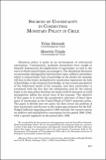Artículo
Sources of uncertainty in conducting monetary policy in Chile
Date
2009Abstract
Monetary policy is made in an environment of substantial uncertainty. Consequently, academic researchers have sought to formally demonstrate the implications of uncertainty, as well as the ways in which central banks can manage it. The theoretical literature on uncertainty distinguishes between three types: additive uncertainty refers to central banks’ lack of knowledge on the shocks the economy will face in the future, multiplicative uncertainty represents the lack of knowledge, or the erroneous knowledge, on one or more parameters of the behavioral model of the economy, and data uncertainty is associated with the fact that the information used by the central bank at the time policy decisions are made could be incorrect or could incompletely reflect the actual state of the economy. The objective of this paper is to review the quantitative relevance of these three types of uncertainty in the Central Bank of Chile’s monetary policy.
Collections
View/


